Palaeoecology as a Tool for the Future Management of Forest Ecosystems in Hesse (Central Germany): Beech (Fagus sylvatica L.) versus Lime (Tilia cordata Mill.)
Abstract
:1. Introduction
- The Subboreal chronozone has been characterised by a warm and dry climate with air temperatures 1.0–3.5 °C above modern levels. Between 7000 and 4000 cal. BP (Holocene Climate Optimum), the range of Tilia advanced 300 km north compared to its modern distribution.
- At that time, the mixed deciduous forests were already partly cleared and extensively used. The development of increasingly complex economies, new crops, innovations in metallurgy and the secondary use of domestic animals all contributed to the intensification of human impact.
- Fagus sylvatica, which is considered the potentially natural tree species for the Hessian uplands today, was not yet widespread in the forests, and Picea abies was completely absent.
2. Material and Methods
2.1. Study Area
2.2. Pollen Sampling
2.3. Dating and Pollen Analysis
2.4. R Values and Rank Correlation
3. Results and Discussion
3.1. Forests in the Hessian Uplands during the Warm and Moist Atlantic
3.2. More Than 2000 Years of Stable Deciduous Forests under Warm and Dry Climatic Conditions
3.3. Beech Takes Advantage of the Moment
- An advancement of Fagus, triggered by a cooler and more humid climate at the Subboreal/Subatlantic chronozone transition at the expense of Tilia, is obvious. A climate-related hypothesis for the reduction of Tilia stands had already been postulated by Godwin [87] and Firbas [88] and is also proposed by Pigott [89], who attributes the decline of Tilia cordata in England to the inhibited seed production at lower temperatures. This facilitated the spread of Fagus sylvatica. Such a scenario seems plausible for the margins of the Wetterau, but not so much for the Taunus, where, despite cooler and wetter conditions and an evident Fagus expansion, Tilia values remain distinctly high for around 1000 years. Nevertheless, a cooler climate likely had a negative influence on Tilia and gave an advantage to Fagus. This fact, however, is difficult to deduce from palynological records, since Tilia is known to produce pollen but no longer forms any fertile seeds under critical climatic conditions. Due to its ability to reproduce vegetatively and, above all, its high life expectancy of up to 1000 years [90], Tilia could have survived several hundred years and still produce pollen [91] before it finally had to give way to the shade-tolerant Fagus.
- Pathogens contributed to a weakening of Tilia. Since the Middle Bronze Age, when Fagus values do not exceed 1% in the pollen diagrams, but Tilia values reach their peak, for example, in the Taunus, spores of the parasitic fungus Kretzschmaria deusta have increasingly been detected. In northern Poland, a connection was found between a dry phase of the mire and the high incidence of Kretzschmaria deusta in the surrounding forest [92]. In the Taunus, on the other hand, the increase in fungal spores can be paralleled with cooler and more humid climatic conditions, as was equally observed in the Western Carpathians [69]. It is thus possible that both dry and cooler conditions make Tilia susceptible to this fungus. However, the infestation probably does not cause the trees to die, but rather stimulates vegetative reproduction [92]. This possibly also contributed to the long dominance of Tilia in the Taunus.
- There is no doubt that anthropogenic activities also had a significant influence on the spread of Fagus and the decline of Tilia [69,85,86]. At the edges of the Wetterau, the first expansion of Fagus around 4200 cal. BP occurred almost simultaneously with a sharp increase in non-arboreal pollen. At the same time, Tilia values are dropping, indicating forest clearings. In the Taunus, too, the first increase in Fagus at 5800 cal. BP correlates with a rise of non-arboreal pollen, albeit not until a few centuries later (Figure 5 and Figure 7). All subsequent Fagus peaks in the Taunus are associated with initial increases in non-arboreal pollen, except for the period between 3000 and 2800 cal. BP. This final Fagus maximum is probably the result of changes in forest management and settlement behaviour. In many places, disadvantageous climatic conditions made people retreat from higher altitudes and caused a concentration of settlements in the climatically favoured basins. Fagus forests were able to develop in the low mountain ranges with minimal human impact, especially since Tilia was no longer competitive.
3.4. The Forests of the Future as Reflected by the Past
4. Conclusions
Author Contributions
Funding
Institutional Review Board Statement
Informed Consent Statement
Acknowledgments
Conflicts of Interest
References
- Birks, H.J.B. Paleoecology. In Encyclopedia of Ecology, 2nd ed.; Fath, B., Ed.; Elsevier: Amsterdam, The Netherlands, 2019; p. 504. [Google Scholar] [CrossRef]
- Bohn, U.; Gollub, G.; Hettwer, C.; Neuhäuslová, Z.T.; Raus, T.; Schlüter, H.; Weber, H. Map of the Natural Vegetation of Europe, Scale 1:2.500.000; Bundesamt für Naturschutz (Federal Agency for Nature Conversation): Bonn, Germany, 2004.
- Bundesministerium für Ernährung und Landwirtschaft (Federal Ministry of Food and Agriculture, BMEL). The forests in Germany—Selected Results of the Third National Forest Inventory; BMEL: Berlin, Germany, 2015. Available online: https://www.bmel.de/SharedDocs/Downloads/EN/Publications/ForestsInGermany-BWI.html (accessed on 6 April 2021).
- Geßler, A.; Keitel, C.; Kreuzwieser, J.; Matyssek, R.; Seiler, W.; Rennenberg, H. Potential risks for European beech (Fagus sylvatica L.) in a changing climate. Trees 2007, 21, 1–11. [Google Scholar] [CrossRef]
- Jump, A.S.; Hunt, J.M.; Peñuelas, J. Rapid climate change-related growth decline at the southern range edge of Fagus sylvatica. Glob. Change Biol. 2006, 12, 2163–2174. [Google Scholar] [CrossRef] [Green Version]
- Bundesministerium für Ernährung und Landwirtschaft (Federal Ministry of Food and Agriculture, BMEL). Ergebnisse der Waldzustandserhebung 2020; BMEL: Berlin, Germany, 2021. Available online: https://www.bmel.de/SharedDocs/Downloads/DE/Broschueren/ergebnisse-waldzustandserhebung-2020.pdf?__blob=publicationFile&v=8 (accessed on 9 April 2021).
- Schäfer, M. Pollenanalysen an Mooren des Hohen Vogelsberges (Hessen)—Beiträge zur Vegetationsgeschichte und Anthropogenen Nutzung eines Mittelgebirges; J. Cramer: Stuttgart, Germany, 1996. [Google Scholar]
- Schmenkel, G. Pollenanalytische Untersuchungen im Taunus. Ber. Komm. Archäolog. Landesforsch. Hess. 2001, 6, 225–232. [Google Scholar]
- Steckhan, H.U. Pollenanalytisch vegetationskundliche Untersuchungen zur frühen Siedlungsgeschichte im Vogelsberg, Knüll und Solling. Flora 1961, 150, 514–551. [Google Scholar]
- Stobbe, A. Die Holozäne Vegetationsgeschichte der NöRdlichen Wetterau. Paläoökologische Untersuchungen unter Besonderer Berücksichtigung Anthropogener Einflüsse; J. Cramer: Stuttgart, Germany, 1996. [Google Scholar]
- Stobbe, A. Die Vegetationsentwicklung in der Wetterau und im Lahntal in den Jahrhunderten um Christi Geburt. Ein Vergleich der palynologischen Ergebnisse. In Kelten, Germanen, Römer im Mittelgebirgsraum zwischen Luxemburg und Thüringen; Haffner, A., von Schnurbein, S., Eds.; Habelt: Bonn, Germany, 2000; pp. 201–219. [Google Scholar]
- Stobbe, A. Die Wetterau und der Glauberg—Veränderungen der Wirtschaftsmethoden von der späten Bronzezeit zur Frühlatènezeit. In Frühe Zentralisierungs- und Urbanisierungsprozesse. Zur Genese und Entwicklung Frühkeltischer Fürstensitze und Ihres Territorialen Umlandes; Kolloquium des DFG-Schwerpunktprogramms 1171, Blaubeuren, Germany, 9–11 October 2006; Krausse, D., Steffen, C., Eds.; Theiss: Stuttgart, Germany, 2008; pp. 97–114. [Google Scholar]
- Stobbe, A. Das perfekte vegetationsgeschichtliche Archiv—Eine Frage der Perspektive. In Kontrapunkte, Festschrift für Manfred Rösch; Habelt: Bonn, Germany, 2017; pp. 217–222. [Google Scholar]
- Stobbe, A.; Bringemeier, L. Die Waldentwicklung zwischen Neolithikum und Eisenzeit in der hessischen Mittelgebirgszone vor dem Hintergrund anthropogener und klimatischer Einflüsse. In Prehistoric Conflict Research. The history of war and conflict. In Proceedings of the Fourth International LOEWE Conference, Frankfurt (Main), Germany, 7–9 October 2020; Hansen, S., Krause, R., Eds.; in press. [Google Scholar]
- Bradley, L.R.; Giesecke, T.; Halsall, K.; Bradshaw, R.H.W. Exploring the requirement for anthropogenic disturbance to assist the stand-scale expansion of Fagus sylvatica outside southern Scandinavia. Holocene 2013, 23, 579–586. [Google Scholar] [CrossRef]
- Magri, D.; Vendramin, G.G.; Comps, B.; Dupanloup, I.; Geburek, T.; Gomory, D.; Latalowa, M.; Litt, T.; Paule, L.; Roure, J.M.; et al. A new scenario for the Quaternary history of European beech populations: Palaeobotanical evidence and genetic consequences. New Phytol. 2006, 171, 199–221. [Google Scholar] [CrossRef] [PubMed]
- Tinner, W.; Lotter, A.F. Holocene expansions of Fagus silvatica and Abies alba in Central Europe: Where are we after eight decades of debate? Quat. Sci. Rev. 2006, 25, 526–549. [Google Scholar] [CrossRef]
- Bradshaw, R.H.W.; Kito, N.; Giesecke, T. Factors influencing the Holocene history of Fagus. For. Ecol. Manag. 2010, 11, 2204–2212. [Google Scholar] [CrossRef]
- Giesecke, T.; Hickler, T.; Kunkel, T.; Sykes, M.T.; Bradshaw, R.H.W. Towards an understanding of the Holocene distribution of Fagus sylvatica L. J. Biogeogr. 2007, 34, 118–131. [Google Scholar] [CrossRef]
- Giesecke, T.; Brewer, S.; Finsinger, W.; Leydet, M.; Bradshaw, R.H. Patterns and dynamics of European vegetation change over the last 15,000 years. J. Biogeogr. 2017, 44, 1441–1456. [Google Scholar] [CrossRef] [Green Version]
- Van der Knaap, W.O.; van Leeuwen, J.F.N.; Ammann, B. Seven years of annual pollen influx at the forest limit in the Swiss Alps studied by pollen traps: Relations to vegetation and climate. Rev. Palaeobot. Palynol. 2001, 117, 31–52. [Google Scholar] [CrossRef]
- Rösch, M. Human impact as registered in the pollen record: Some results from the western Lake Constance region, Southern Germany. Veget. Hist. Archaeob. 1992, 1, 101–109. [Google Scholar] [CrossRef]
- Lechterbeck, J. “Human Impact” oder “Climatic Changes”? Zur Vegetationsgeschichte des Spätglazials und Holozäns in Hochauflösenden Pollenanalysen Laminierter Sedimente des Steißlinger Sees (Südwestdeutschland); Institut und Museum für Geologie und Paläontologie (Institute and Museum for Geology and Paleontology): Tübingen, Germany, 2001. [Google Scholar]
- Gliemeroth, A.K. Paläoökologische Untersuchungen über Die Letzten 22’000 Jahre in Europa: Vegetation, Biomasse und Einwanderungsgeschichte der Wichtigsten Waldbäume; G. Fischer: Stuttgart, Germany, 1995. [Google Scholar]
- Huntley, B.; Birks, H.J.B. An Atlas of Past and Present Pollen Maps for Europe 0–13,000 Years Ago; Cambridge University Press: Cambridge, UK, 1983. [Google Scholar]
- Schulze, E.D.; Hessenmöller, D.; Seele, C.; Wäldchen, J.; von Lüpke, N. Die Buche: Eine Kultur- und Wirtschaftsgeschichte. Biol. Unserer Zeit 2010, 3, 171–183. [Google Scholar] [CrossRef]
- Bottema, S. Back to Nature? Objectives of nature managements in view of archeological research. In Archaeologie en Landschap; Bierma, M., Harsema, O.H., van Zeist, W., Eds.; BAI, Rijksuniversiteit Groningen: Groningen, The Netherlands, 1988; pp. 185–206. [Google Scholar]
- De Jaegere, T.; Hein, S.; Claessens, H.A. Review of the Characteristics of Small-Leaved Lime (Tilia cordata Mill.) and Their Implications for Silviculture in a Changing Climate. Forests 2016, 7, 56. [Google Scholar] [CrossRef] [Green Version]
- Latte, N.; Taverniers, P.; de Jaegere, T.; Claessens, H. Dendroecological assessment of climate resilience of the rare and scattered forest tree species Tilia cordata Mill. in northwestern Europe. For. Int. J. For. Res. 2020, 93, 675–684. [Google Scholar] [CrossRef]
- Baumbach, L.; Niamir, A.; Hickler, T.; Yousefpour, R. Regional adaptation of European beech (Fagus sylvatica) to drought in Central European conditions considering environmental suitability and economic implications. Reg. Environ. Chang. 2019, 19, 1159–1174. [Google Scholar] [CrossRef]
- Hanewinkel, M.; Cullmann, D.A.; Schelhaas, M.-J.; Nabuurs, G.-J.; Zimmermann, N.E. Climate change may cause severe loss in the economic value of European forest land. Nat. Clim. Chang. 2013, 3, 203–207. [Google Scholar] [CrossRef]
- Henne, P.D.; Elkin, C.; Franke, J.; Colombaroli, D.; Calo, C.; La Mantia, T.; Pasta, S.; Conedera, M.; Dermody, O.; Tinner, W. Reviving extinct Mediterranean forests increases eco-system potential in a warmer future. Front. Ecol. Environ. 2015, 13, 356–362. [Google Scholar] [CrossRef] [Green Version]
- Hickler, T.; Vohland, K.; Feehan, J.; Miller, P.A.; Smith, B.; Costa, L.; Giesecke, T.; Fronzek, S.; Carter, T.R.; Cramer, W.; et al. Projecting the future distribution of European potential natural vegetation zones with a generalized, tree species-based dynamic vegetation model. Glob. Ecol. Biogeogr. 2012, 21, 50–63. [Google Scholar] [CrossRef]
- Maiorano, L.; Cheddadi, R.; Zimmermann, N.E.; Pellissier, L.; Petitpierre, B.; Pottier, J.; Laborde, H.; Hurdu, B.I.; Pearman, P.B.; Psomas, A.; et al. Building the niche through time: Using 13,000 years of data to predict the effects of climate change on three tree species in Europe. Glob. Ecol. Biogeogr. 2013, 22, 302–317. [Google Scholar] [CrossRef]
- Tinner, W.; Colombaroli, D.; Heiri, O.; Henne, P.D.; Steinachter, M.; Untenecker, J.; Vescovi, E.; Allen, J.R.M.; Carraro, G.; Conedera, M.; et al. The past ecology of Abies alba provides new perspectives on future responses of silver fir forests to global warming. Ecol. Monogr. 2013, 83, 419–439. [Google Scholar] [CrossRef] [Green Version]
- Tinner, W.; Conedera, M.; Bugmann, H.; Colombaroli, D.; Gobet, E.; Vescovi, E.; Heiri, O.; Joos, F.; Luterbacher, J.; La Mantia, T.; et al. Europäische Wälder unter wärmeren Klimabedingungen: Neue Erkenntnisse aus Paläoökologie und dynamischer Vegetationsmodellierung. AFZ/Der Wald 2016, 71, 45–49. [Google Scholar]
- Davis, B.A.S.; Collins, P.M.; Kaplan, J.O. The age and post-glacial development of the modern European vegetation: A plant functional approach based on pollen data. Veg. Hist. Archaeobot. 2015, 24, 303–317. [Google Scholar] [CrossRef]
- Projektstart: „ArchaeoForest—Mittelalterliche Waldzusammensetzung als Basis forstwirtschaftlicher Anpassungen an den Klimawandel“. Available online: https://archaeologie.sachsen.de/projektstart-archaeoforest-mittelalterliche-waldzusammensetzung-als-basis-forstwirtschaftlicher-anpassungen-an-den-klimawandel-7279.html (accessed on 14 April 2021).
- Schwörer, C.; Henne, P.D.; Tinner, W. A model-data comparison of Holocene timberline changes in the Swiss Alps reveals past and future drivers of mountain forest dynamics. Glob. Chang. Biol. 2014, 20, 1512–1526. [Google Scholar] [CrossRef] [PubMed]
- Milligan, G.; Bradshaw, R.H.W.; Clancy, D.; Żychaluk, Z.; Spencer, M. Effects of human land use and temperature on community dynamics in European forests. Quat. Sci. Rev. 2020, 247, 106458. [Google Scholar] [CrossRef]
- Fischer, E.; Rösch, M.; Sillmann, M.; Ehrmann, O.; Liese-Kleiber, H.; Voigt, R.; Stobbe, A.; Kalis, A.J.; Stephan, E.; Schatz, K.; et al. Landnutzung im Umkreis der Zentralorte Hohenasperg, Heuneburg und Ipf. Archäobotanische und archäozoologische Untersuchungen und Modellberechnungen zum Erntepotential von Ackerbau und Viehzucht. In Proceedings of the "Fürstensitze” und Zentralorte der frühen Kelten, Abschlusskolloquium des DFG-Schwerpunktprogramms 1171, Stuttgart, Germany, 12–15 October 2009; Krausse, D., Ed.; Theiss: Stuttgart, Germany, 2010; pp. 195–266. [Google Scholar]
- Stobbe, A. Palynological and Archaeological Data—A Comparative Approach. In Layers of Percezption; Proceedings of the 35th International Conference on Computer Applications and Quantitative Methods in Archaeology (CAA), Berlin, Germany, 2–6 April 2007; Posluschny, A., Lambers, K., Herzog, I., Eds.; R. Habelt: Bonn, Germany, 2008. [Google Scholar]
- Stobbe, A. Die Wetterau in römischer Zeit—Eine waldfreie Landschaft? In Proceedings of the Kelten am Rhein. Akten des dreizehnten internationalen Keltenkongresses, Bonn, Germany, 23–27 July 2007; Zimmer, S., Ed.; P. von Zabern: Mainz, Germany, 2009; pp. 251–261. [Google Scholar]
- Blaauw, M.; Christen, J.A. Flexible paleoclimate age-depth models using an autoregressive gamma process. Bayesian Anal. 2011, 6, 457–474. [Google Scholar] [CrossRef]
- Fægri, K.; Iversen, J. Textbook of Pollen Analysis, 4th ed.; Blackwell: Chichester, UK, 1989. [Google Scholar]
- Moore, P.D.; Webb, J.A.; Collinson, M.E. Pollen analysis, 2nd ed.; Wiley: London, UK, 1991. [Google Scholar]
- Punt, W.; Clarke, G.C.S. The Northwest European Pollen Flora I-IX; Elsevier: Amsterdam, The Netherlands, 1976–2009. [Google Scholar]
- Reille, M. Pollen et spores d’Europe et d’Afrique du Nord; Laboratoire de Botanique Historique et Palynologie: Marseille, France, 1992. [Google Scholar]
- Reille, M. Pollen et spores d’Europe et d’Afrique du Nord: Supplément 2; Laboratoire de Botanique Historique et Palynologie: Marseille, France, 1998. [Google Scholar]
- Sugita, S. Theory of quantitative reconstruction of vegetation I: Pollen from large sites REVEALS regional vegetation. Holocene 2007, 17, 229–241. [Google Scholar] [CrossRef]
- Sugita, S. Theory of quantitative reconstruction of vegetation II: All you need is LOVE. Holocene 2007, 17, 243–257. [Google Scholar] [CrossRef]
- Mrotzek, A.; Couwenberg, J.; Theuerkauf, M.; Joosten, H. MARCO POLO—A new and simple tool for pollen-based stand-scale vegetation reconstruction. Holocene 2017, 27, 321–330. [Google Scholar] [CrossRef]
- Birks, H.J.B.; Birks, H.H. Quaternary Palaeoecology; E. Arnold: London, UK, 1980. [Google Scholar]
- Andersen, S.T. The Relative Pollen Productivity and Pollen Representation of North European Trees, and Correction Factors for Tree Pollen Spectra; C. A. Reitzel: Copenhagen, Denmark, 1970. [Google Scholar]
- Feeser, I.; Dörfler, W. The glade effect: Vegetation openness and structure and their influences on arboreal pollen production and the reconstruction of anthropogenic forest opening. Anthropocene 2014, 8, 92–100. [Google Scholar] [CrossRef]
- Borzenkova, I.; Zorita, E.; Borisova, O.; Kalniņa, L.; Kisielienė, D.; Koff, T.; Kuznetsov, D.; Lemdahl, G.; Sapelko, T.; Stančikaitė, M.; et al. Climate Change During the Holocene (Past 12,000 Years). In Second Assessment of Climate Change for the Baltic Sea Basin; BACC II Author Team, Ed.; Springer Open: Cham, Switzerland, 2015; pp. 25–49. [Google Scholar] [CrossRef] [Green Version]
- Davis, B.A.S.; Brewer, S.; Stevenson, A.S.; Guiot, J. The temperature of Europe during the Holocene reconstructed from pollen data. Quat. Sci. Rev. 2003, 22, 1701–1716. [Google Scholar] [CrossRef]
- Schmidt, B.; Gruhle, W. Niederschlagsschwankungen in Westeuropa während der letzten 8000 Jahre. Versuch einer Rekonstruktion mit Hilfe eines neuen dendrochronologischen Verfahrens (Grad der Wuchshomogenität). Archäolog. Korresp. 2003, 33, 281–300. [Google Scholar]
- Schweizer, A. Archäopalynologische Untersuchungen zur Neolithisierung der Nördlichen Wetterau/Hessen; J. Cramer: Stuttgart, Germany, 2001. [Google Scholar]
- Schweizer, A.; Kalis, A.J. Die Waldbedeckung zur Zeit der Bandkeramik in Süd- und Mittelhessen. Ber. Komm. Archäolog. Landesforsch. Hess. 2006, 8, 127–133. [Google Scholar]
- Kalis, A.J.; Merkt, J.; Wunderlich, J. Environmental changes during the Holocene climatic optimum in central Europe—Human impact and natural causes. Quat. Sci. Rev. 2003, 22, 33–79. [Google Scholar] [CrossRef] [Green Version]
- Gerlach, R.; Fischer, P.; Eckmeier, E.; Hilgers, A. Buried dark soil horizons and archaeological features in the Neolitihic settlement region of the Lower Rhine Area, NW Germany: Formation, geochemistry and chronostratigraphy. Quat. Int. 2012, 265, 191–201. [Google Scholar] [CrossRef]
- Kalis, A.J.; Meurers-Balke, J. Zur pflanzensoziologischen Deutung archäobotanischer Befunde. Zwei Pollendiagramme aus dem Wurmtal (Aldenhover Platte). In Archäologische Perspektiven. Analysen und Interpretationen im Wandel. Festschrift für Jens Lüning zum 65. Geburtstag; Eckert, J., Eisenhauer, U., Zimmermann, A., Eds.; M. Leidorf: Rahden, Germany, 2003; pp. 252–277. [Google Scholar]
- Rösch, M.; Biester, H.; Bogenrieder, A.; Eckmeier, E.; Ehrmann, O.; Gerlach, R.; Hall, M.; Hartkopf-Fröder, C.; Herrmann, L.; Kury, B.; et al. Spätneolithischer Ackerbau im Experiment—Eine Zwischenbilanz nach 12 Jahren Forchtenberg. In Umweltarchäologie—Naturkatastrophen und Umweltwandel im archäologischen Befund; Proceedings of the 3. Mitteldeutscher Archäologentag, Halle, Germany, 7–9 October 2010; Bork, H.R., Meller, H., Gerlach, R., Eds.; Landesamt für Denkmalpflege und Archäologie Sachsen-Anhalt: Halle (Saale), Germany, 2011; pp. 175–192. [Google Scholar]
- Rösch, M.; Biester, H.; Bogenrieder, A.; Eckmeier, E.; Ehrmann, O.; Gerlach, R.; Hall, M.; Hartkopf-Fröder, C.; Herrmann, L.; Kury, B.; et al. Late Neolithic Agriculture in Temperate Europe—A Long-Term Experimental Approach. Land 2017, 6, 11. [Google Scholar] [CrossRef]
- Rösch, M.; Lechterbeck, J. Seven Millennia of human impact as reflected in a high resolution pollen profile from the profundal sediments of Litzelsee, LakeConstance region, Germany. Veget. Hist. Archaeob. 2016, 25, 339–358. [Google Scholar] [CrossRef] [Green Version]
- Barzdajn, W. Generative propagation. In Lipy—Tilia cordata Mill., Tilia platyphyllos Scop. Nasze drzewa leśne; Białobok, S., Ed.; Arkadia: Poznań, Poland, 1991; pp. 262–275. [Google Scholar]
- Pigott, C.D. Tilia cordata Miller. J. Ecol. 1991, 79, 1147–1207. [Google Scholar] [CrossRef]
- Kołaczek, P.; Margielewski, W.; Gałka, M.; Karpińska-Kołaczek, M.; Buczek, K.; Lamentowicz, M.; Borek, A.; Zernitskaya, V.; Marcisz, K. Towards the understanding of fire impact on the lower montane forest in the Polish Western Carpathians during the Holocene. Quat. Sci. Rev. 2020, 229, 106137. [Google Scholar] [CrossRef]
- Schäfer, M. Grünland im Hohen Vogelsberg (Hessen) in prähistorischer Zeit—Ergebnisse von Bodenpollenanalysen. Archäolog. Korresp. 1991, 21, 477–488. [Google Scholar]
- Bond, G.; Kromer, B.; Beer, J.; Muscheler, R.; Evans, M.N.; Showers, W.; Hoffmann, S.; Lotti-Bond, R.; Hajdas, I.; Bonani, G. Persistent Solar Influence in North Atlantic Climate During the Holocene. Science 2001, 295, 2130–2136. [Google Scholar] [CrossRef] [PubMed] [Green Version]
- Cullen, H.M.; de Menocal, P.; Hemming, S.; Hemming, G.; Brown, F.H.; Guilderson, T.; Sirocko, F. Climate change and the collapse of the Akkadian empire: Evidence from the deep sea. Geology 2000, 28, 379–382. [Google Scholar] [CrossRef] [Green Version]
- Walker, M.; Head, M.J.; Berkelhammer, M.; Björck, S.; Cheng, G.; Cwynar, L.; Fisher, D.; Gkinis, V.; Walker, A.; Lowe, J.; et al. Formal ratification of the subdivision of the Holocene Series/Epoch (Quaternary System/Period): Two new Global Boundary Stratotype Sections and Points (GSSPs) and three new stage/subseries. Episodes 2018, 41, 213–223. [Google Scholar] [CrossRef] [Green Version]
- Liu, F.; Zeng, Z. A dramatic climatic transition at ~4000 cal. yr BP and its cultural responses in Chinese cultural domains. Holocene 2012, 22, 1181–1197. [Google Scholar] [CrossRef]
- Stanley, J.-D.; Krom, M.D.; Cliff, R.A.; Woodward, J.C. Short contribution: Nile flow failure at the end of the Old Kingdom, Egypt: Strontium isotopic and petrologic evidence. Geoarchaeology 2003, 18, 395–402. [Google Scholar] [CrossRef]
- Staubwasser, M.; Weiss, H. Holocene climate and cultural evolution in late prehistoric-early historic West Asia. Quat. Res. 2006, 66, 372–387. [Google Scholar] [CrossRef] [Green Version]
- Weiss, H.; Bradley, R.S. What Drives Societal Collapse? Science 2001, 26, 609–610. [Google Scholar] [CrossRef] [PubMed] [Green Version]
- Bevan, A.; Colledge, S.; Fuller, D.; Fyfe, R.; Shennan, S.; Stevens, C. Holocene fluctuations in human population demonstrate repeated links to food production and climate. Proc. Natl. Acad. Sci. USA 2017, 114, E10524–E10531. [Google Scholar] [CrossRef] [Green Version]
- Feeser, I.; Dörfler, W.; Kneisel, J.; Hinz, M.; Dreibrodt, S. Human impact and population dynamics in the Neolithic and Bronze Age: Multi-proxy evidence from north-western Central Europe. Holocene 2019, 29, 1596–1606. [Google Scholar] [CrossRef] [Green Version]
- Kolář, J.; Kuneš, P.; Szabó, P.; Hajnalová, M.; Svitavská Svobodová, H.; Macek, M.; Tkáč, P. Population and forest dynamics during the Central European Eneolithic (4500–2000 BC). Archaeol. Anthropol. Sci. 2018, 10, 1153–1164. [Google Scholar] [CrossRef] [PubMed]
- Kaniewski, D.; van Campo, E. 3.2 ka BP Megadrought and the Late Bronze Age Collapse. In Megadrought and Collapse: From Early Agriculture to Angkor; Weiss, H., Ed.; Oxford University Press: Oxford, UK, 2017; pp. 161–182. [Google Scholar]
- Falkenstein, F. Eine Katastrophen-Theorie zum Beginn der Urnenfelderkultur. In Χρόνος. Beiträge zur prähistorischen Archäologie zwischen Nord—Und Südosteuropa. Festschrift für Bernhard Hänsel; Becker, C., Dunkelmann, M.-L., Metzner-Nebelsick, C., Peter-Röcher, H., Roeder, M., Teržan, B., Eds.; M. Leidorf: Espelkamp, Germany, 1997; pp. 549–561. [Google Scholar]
- Jockenhövel, A. Die Bronzezeit. In Die Vorgeschichte Hessens; Herrmann, F.-R., Jockenhövel, A., Eds.; Theiss: Stuttgart, Germany, 1990; pp. 195–243. [Google Scholar]
- Rey, F.; Gobet, E.; Schwörer, C.; Wey, O.; Hafner, A.; Tinner, W. Causes and mechanisms of synchronous succession trajectories in primeval Central European mixed Fagus sylvatica forests. J. Ecol. 2019, 107, 1392–1408. [Google Scholar] [CrossRef] [Green Version]
- Grant, M.J.; Waller, M.W.; Groves, J.A. The Tilia decline: Vegetation change in lowland Britain during the mid and late Holocene. Quat. Sci. Rev. 2011, 3–4, 394–408. [Google Scholar] [CrossRef]
- Turner, J. The Tilia decline: An anthropogenic interpretation. New Phytol. 1962, 61, 328–341. [Google Scholar] [CrossRef]
- Godwin, H. Pollen analysis and forest history of England and Wales. New Phytol. 1940, 39, 370–400. [Google Scholar] [CrossRef]
- Firbas, F. Spät- und Nacheiszeitliche Waldgeschichte Mitteleuropas Nördlich der Alpen, Allgemeine Waldgeschichte; G. Fischer: Jena, Germany, 1949. [Google Scholar]
- Pigott, D. Lime-Trees and Basswoods: A Biological Monograph of the Genus Tilia, 1st ed.; Cambridge University Press: New York, NY, USA, 2012. [Google Scholar]
- Pigott, C.D. Factors controlling the distribution of Tilia cordata Mill at the northern limits of its geographical range. New Phytol. 1989, 112, 117–121. [Google Scholar] [CrossRef]
- Pigott, C.D.; Huntley, J.P. Factors controlling the distribution of Tilia cordata at the northern limits of its geographical range. III. Nature and cause of seed sterility. New Phytol. 1981, 87, 817–839. [Google Scholar] [CrossRef]
- Latałowa, M.; Pędziszewska, A.; Maciejewska, E.; Święta-Musznicka, J. Tilia forest dynamics, Kretzschmaria deusta attack, and mire hydrology as palaeoecological proxies for mid-Holocene climate reconstruction in the Kashubian Lake District (N Poland). Holocene 2013, 23, 667–677. [Google Scholar] [CrossRef]
- Rösch, M. Prehistoric land use as recorded in a lake-shore core at Lake Constance. Veget. Hist. Archaeobot. 1993, 2, 213–232. [Google Scholar] [CrossRef]
- Kalis, A.J.; Meurers-Balke, J. Rezent-geobotanische Überlegungen zur natürlichen Waldvegetation im Subboreal. In 7000 Jahre bäuerliche Landschaft: Entstehung, Erforschung, Erhaltung. Zwanzig Aufsätze zu Ehren von Karl-Heinz Knörzer; Kalis, A.J., Meurers-Balke, J., Habelt, R., Eds.; Rheinland-Verlag: Köln, Germany, 1993; pp. 49–61. [Google Scholar]
- Brunette, M.; Hanewinkel, M.; Yousefpour, R. Risk aversion hinders forestry professionals to adapt to climate change. Clim. Chang. 2020, 162, 2157–2180. [Google Scholar] [CrossRef]
- Lang, G. Quartäre Vegetationsgeschichte Europas; Fischer: Jena, Germany, 1994. [Google Scholar]
- Feurdean, A.; Bhagwat, S.A.; Willis, K.J.; Birks, H.J.; Lischke, H.; Hickler, T. Tree migration-rates: Narrowing the gap between inferred post-glacial rates and projected rates. PLoS ONE 2013, 8, e71797. [Google Scholar] [CrossRef]
- Magyari, E. Holocene biogeography of Fagus sylvatica L. and Carpinus betulus L. in the Carpathian-Alpine Region. Folia Hist. Nat. Musei Matra. 2003, 26, 15–35. [Google Scholar]
- Tanţău, I.; Reille, M.; de Beaulieu, J.-L.; Fărcaş, S.; Brewer, S. Holocene vegetation history in Romanian Subcarpathians. Quat. Res. 2009, 72, 164–173. [Google Scholar] [CrossRef]
- Aas, G. Die Winterlinde (Tilia cordata): Verwandtschaft, Morphologie und Ökologie. In Beiträge zur Winderlinde; Schmidt, O., Ed.; Bayerische Landesanstalt für Wald und Forstwirtschaft (Bavarian Institute of Forestry, LWF): Freising, Germany, 2016; pp. 7–13. Available online: https://www.lwf.bayern.de/mam/cms04/waldbau-bergwald/dateien/w78_winterlinde_verwandtschaft_morphologie_oekologie.pdf (accessed on 9 April 2021).
- Dyderski, M.K.; Paź, S.; Frelich, L.E.; Jagodziński, A.M. How much does climate change threaten European forest tree species distributions? Glob. Chang. Biol. 2018, 24, 1150–1163. [Google Scholar] [CrossRef]
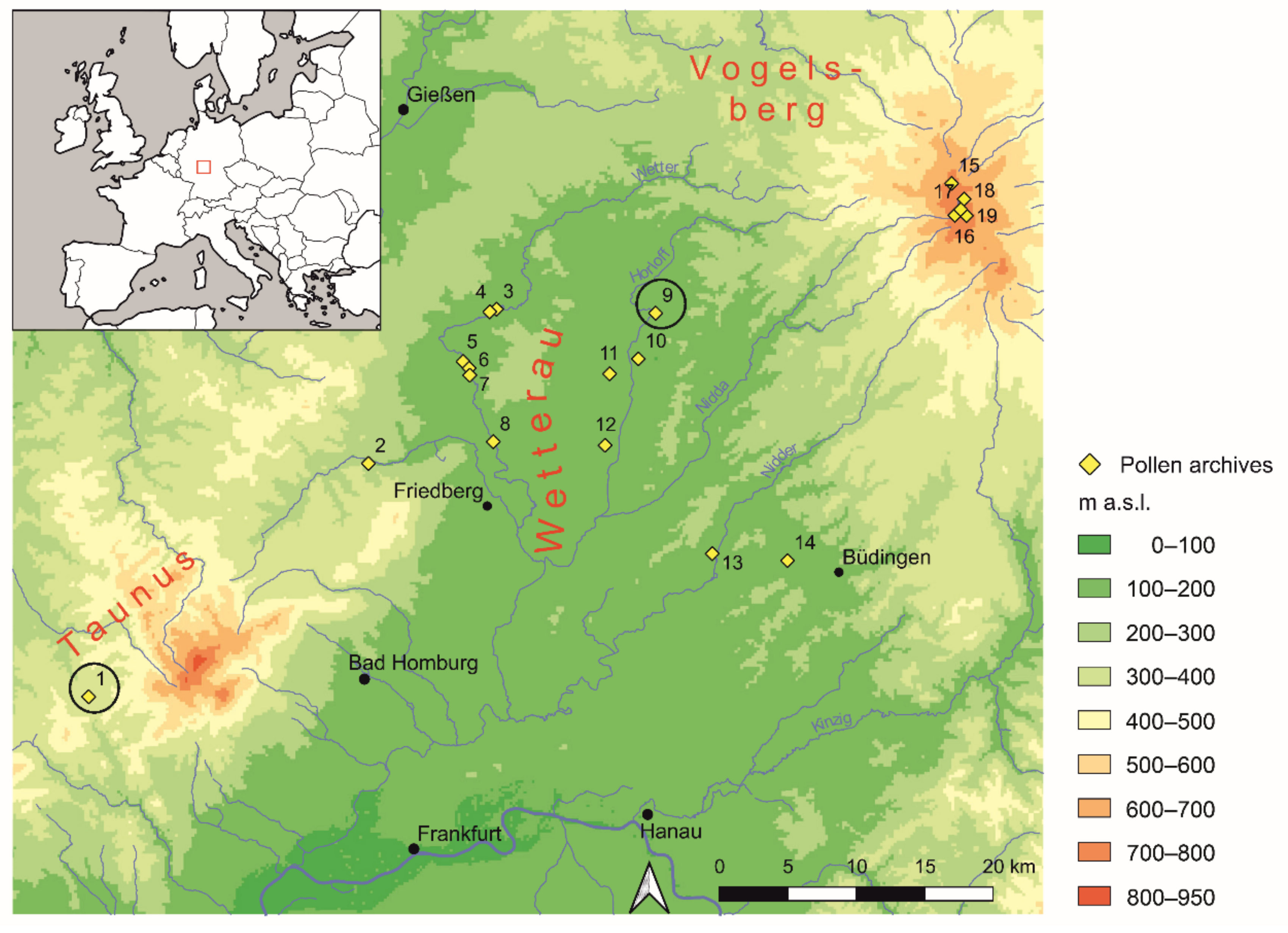
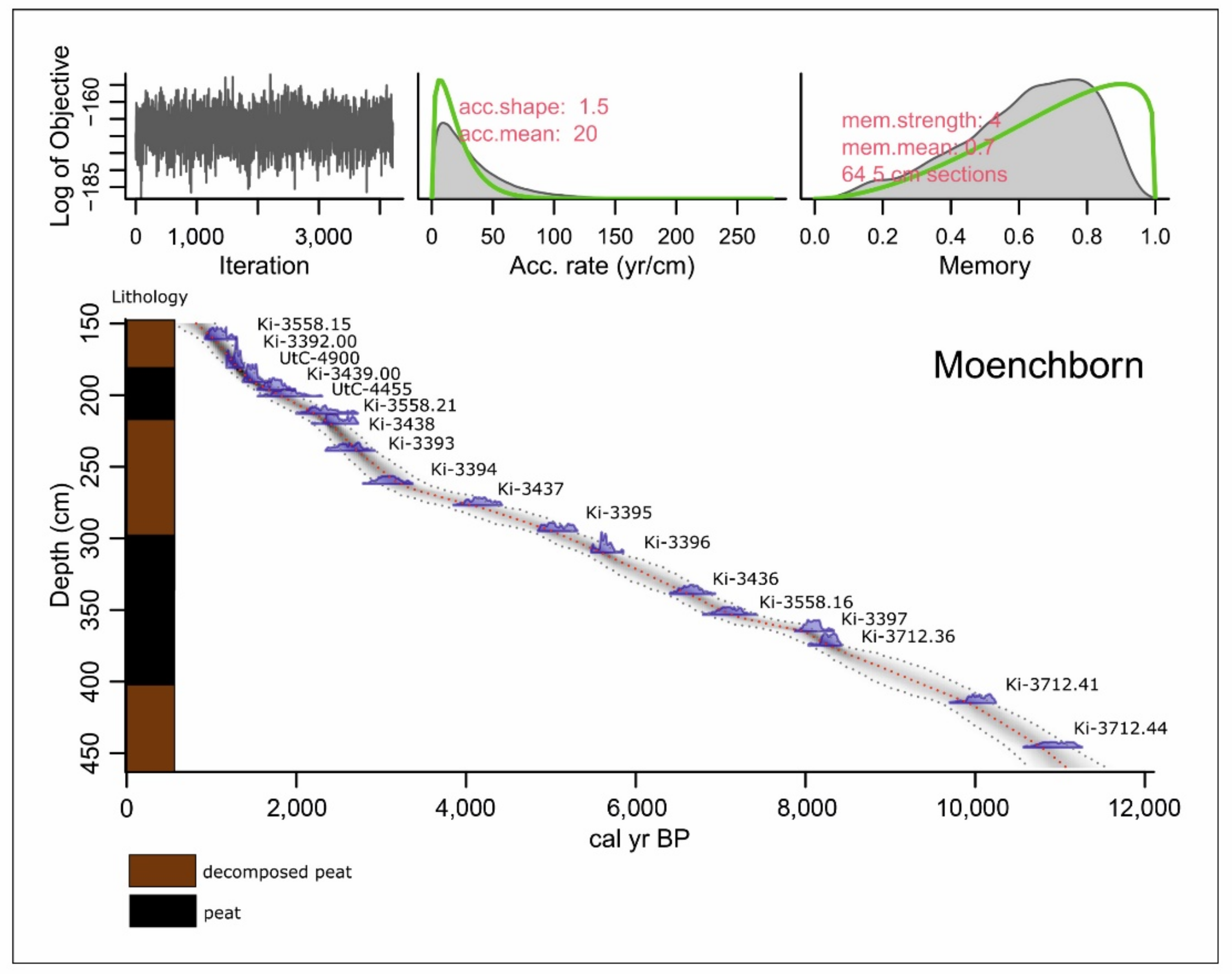
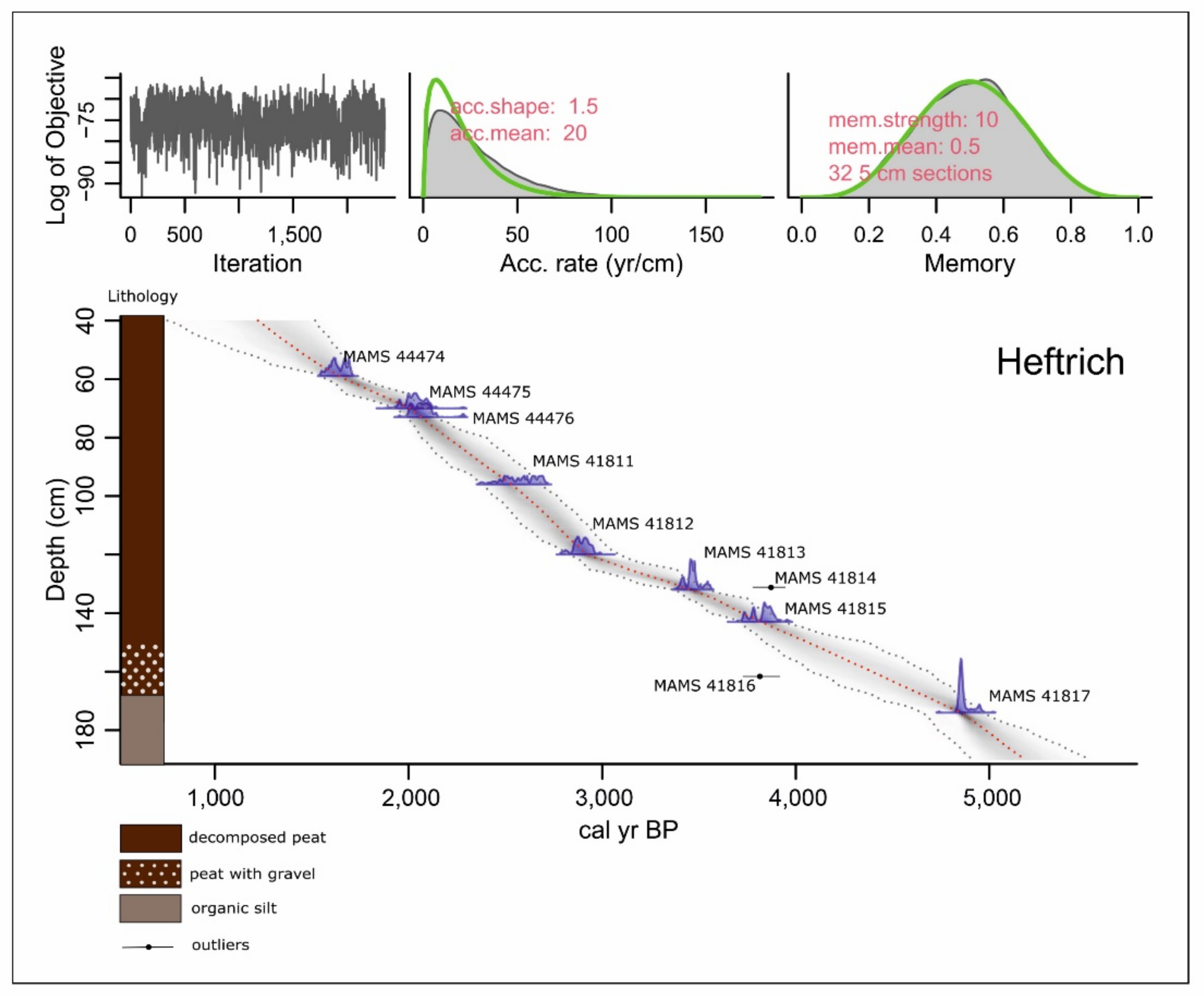
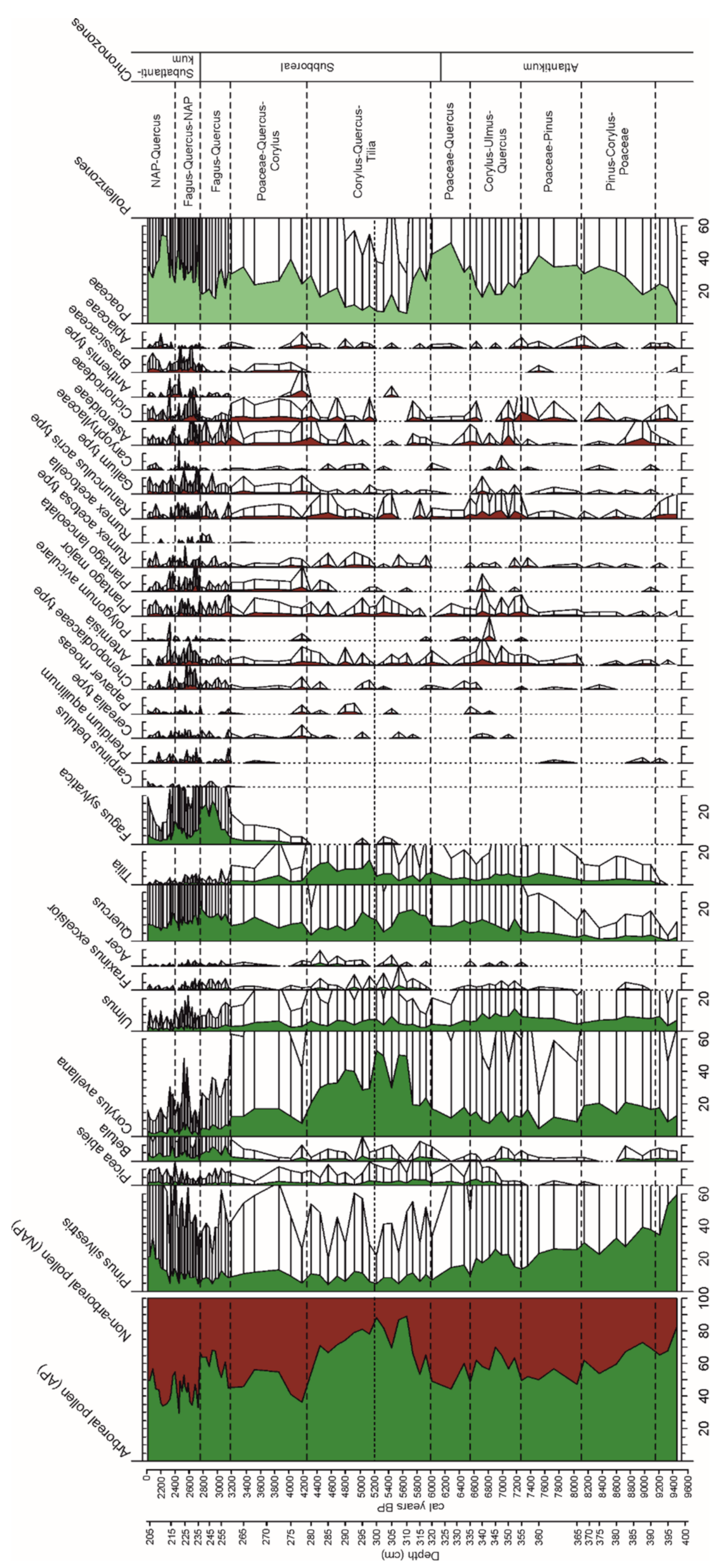
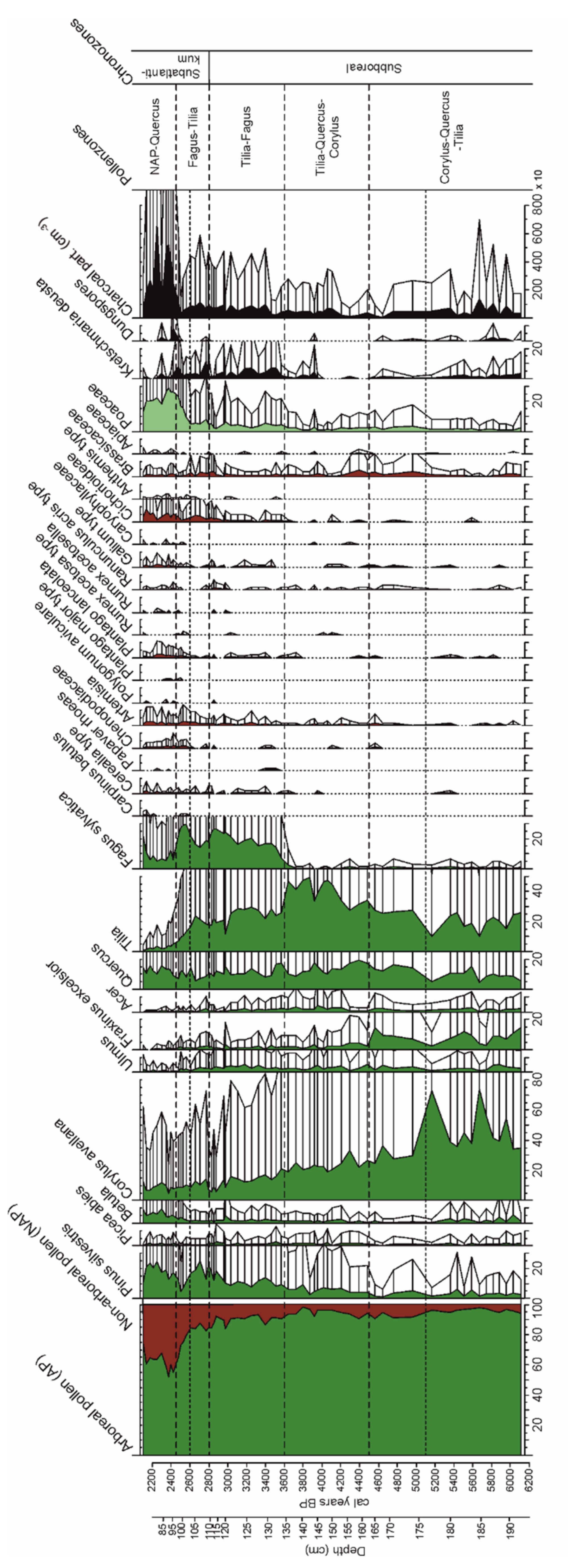

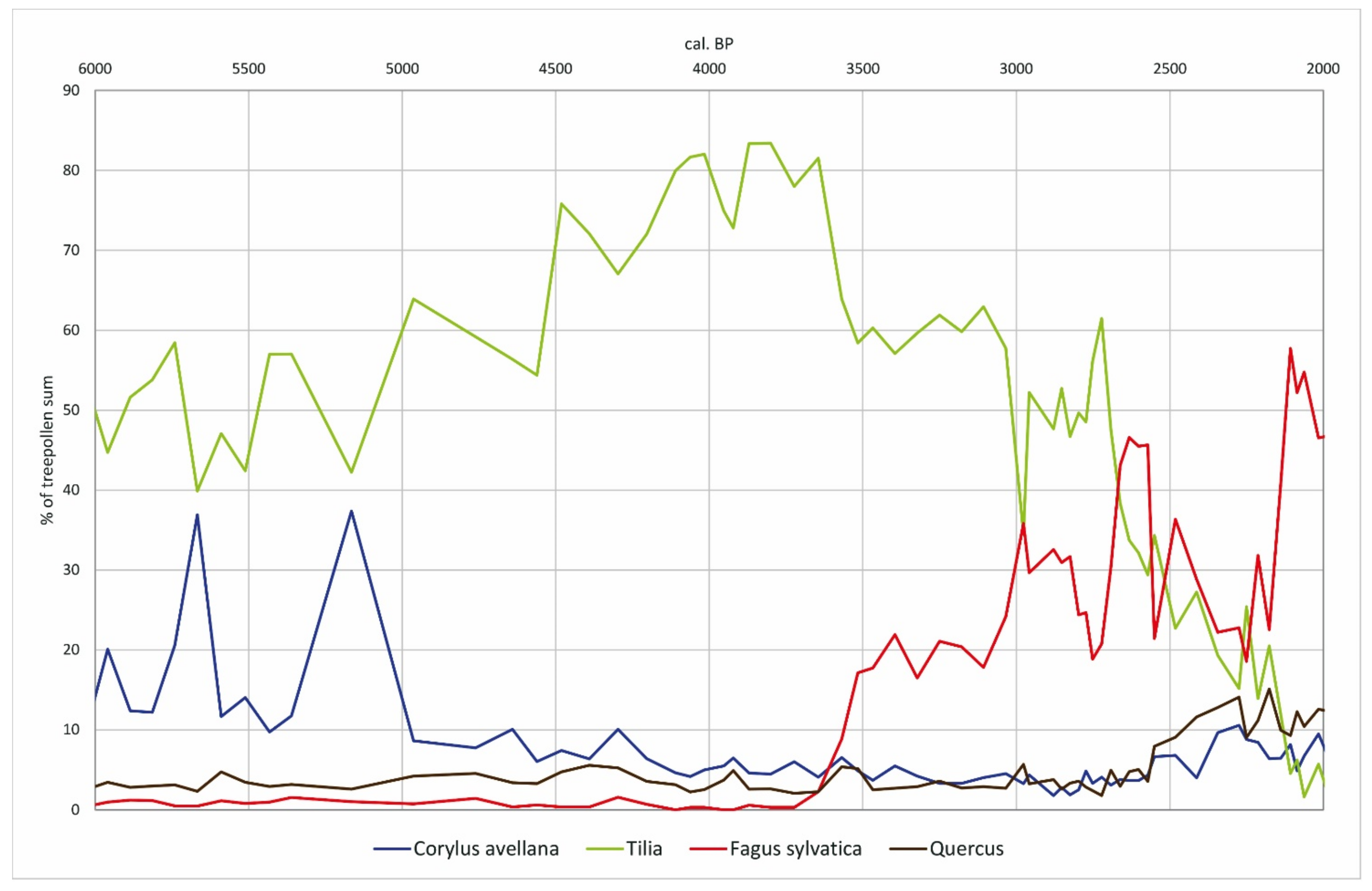
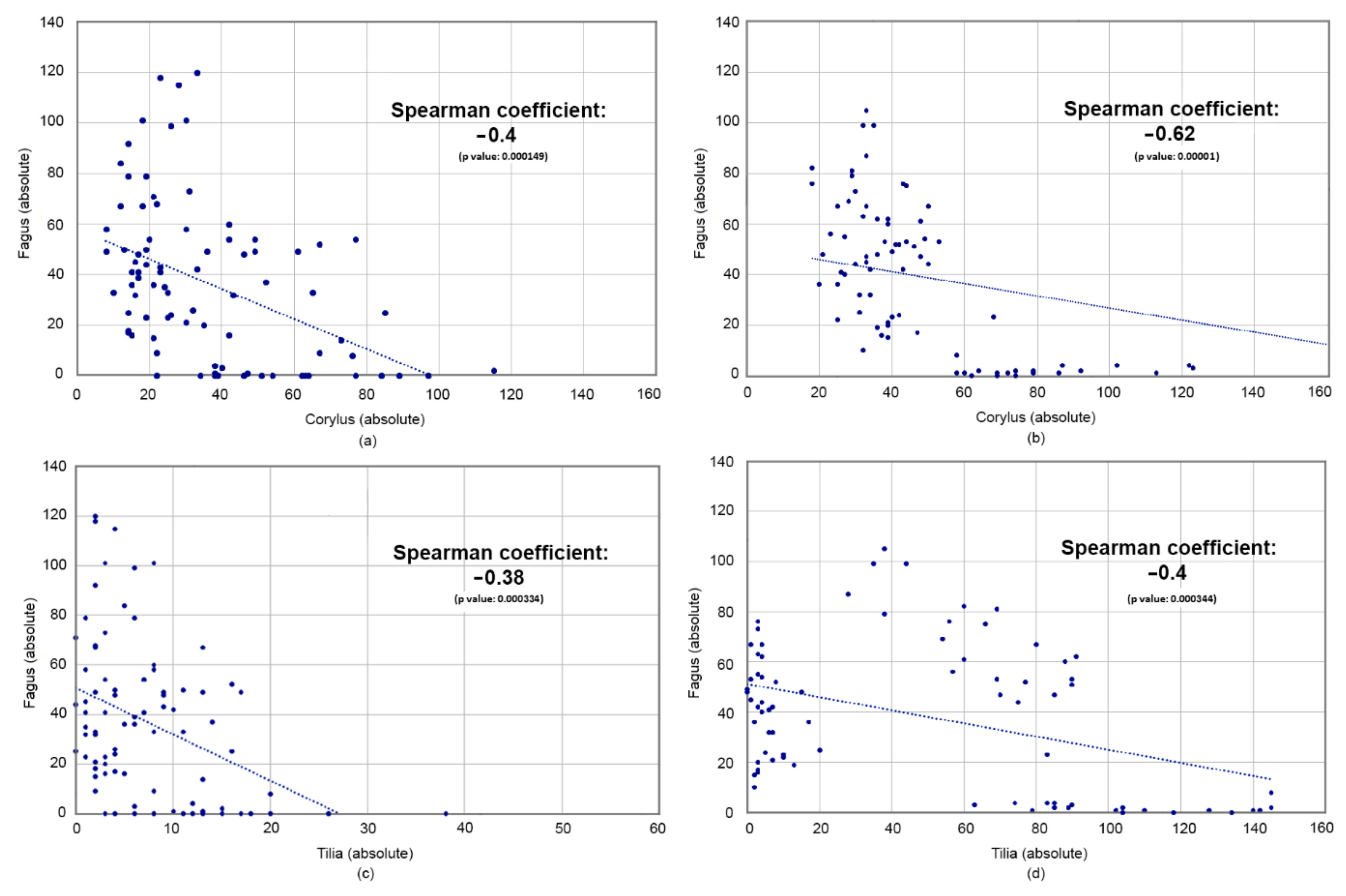
| Location | Sample Depth (cm) | Laboratory Code- Number | 14C date BP | Age (cal. BP) (2σ 95.4%) | Delta 13 | Dated Material |
|---|---|---|---|---|---|---|
| Moenchborn | 160–162 | Ki-3558.15 | 1160 ± 60 | 1249–934 | −28.2 | peat |
| Moenchborn | 179–184 | Ki-3392.00 | 1370 ± 50 | 1360–1176 | −29 | peat |
| Moenchborn | 190–193 | UtC-4900 | 1612 ± 41 | 1570–1389 | −31.3 | peat |
| Moenchborn | 195–198 | Ki-3439.00 | 1840 ± 65 | 1923–1585 | −28.4 | peat |
| Moenchborn | 200–202 | UtC-4455 | 1950 ± 100 | 2146–1620 | −26 | peat |
| Moenchborn | 212–215 | Ki-3558.21 | 2300 ± 90 | 2700–2061 | −28.4 | peat |
| Moenchborn | 218–222 | Ki-3438 | 2400 ± 60 | 2705–2338 | −28.4 | peat |
| Moenchborn | 237–242 | Ki-3393 | 2560 ± 90 | 2845–2360 | −29.5 | peat |
| Moenchborn | 260–265 | Ki-3394 | 2930 ± 75 | 3332–2873 | −27.9 | peat |
| Moenchborn | 276–279 | Ki-3437 | 3780 ± 75 | 4408–3934 | −30.3 | peat |
| Moenchborn | 293–298 | Ki-3395 | 4430 ± 55 | 5285–4867 | −28.6 | peat |
| Moenchborn | 308–313 | Ki-3396 | 4890 ± 55 | 5745–5478 | −28.3 | peat |
| Moenchborn | 338–341 | Ki-3436 | 5840 ± 80 | 6850–6445 | −29.8 | peat |
| Moenchborn | 351–355 | Ki-3558.16 | 6210 ± 90 | 7319–6884 | −27.1 | peat |
| Moenchborn | 363–368 | Ki-3397 | 7270 ± 75 | 8298–7938 | −27 | peat |
| Moenchborn | 373–377 | Ki-3712.36 | 7480 ± 70 | 8413–8058 | −27.4 | peat |
| Moenchborn | 413–417 | Ki-3712.41 | 8940 ± 65 | 10,235–9798 | −28.1 | peat |
| Moenchborn | 444–448 | Ki-3712.44 | 9620 ± 100 | 11,226–10,688 | −29.2 | peat |
| Heftrich | 58–60 | MAMS 44474 | 1741 ± 21 | 1705–1567 | −24.2 | peat |
| Heftrich | 70–71 | MAMS 44475 | 2073 ± 26 | 2118–1944 | −29 | peat |
| Heftrich | 73–74 | MAMS 44476 | 2106 ± 22 | 2143–1997 | −26.6 | peat |
| Heftrich | 96–97 | MAMS 41811 | 2471 ± 20 | 2710–2429 | −26.1 | peat |
| Heftrich | 120–121 | MAMS 41812 | 2793 ± 21 | 2960–2801 | −24.2 | peat |
| Heftrich | 132–133 | MAMS 41813 | 3256 ± 21 | 3557–3400 | −22.7 | peat |
| Heftrich | 137–138 | MAMS 41814 | 3611 ± 22 | 3980–3845 | −26.6 | peat |
| Heftrich | 143–144 | MAMS 41815 | 3547 ± 20 | 3900–3724 | −24.1 | peat |
| Heftrich | 162–163 | MAMS 41816 | 3560 ± 20 | 3959–3728 | −26.7 | peat |
| Heftrich | 174–175 | MAMS 41817 | 4300 ± 21 | 4952–4833 | −25.9 | organic silt |
| Depth (cm) | PAZ | Approximate Age (cal. BP) | Palynological Characterisation |
|---|---|---|---|
| 390–366 | Pinus–Corylus–Poaceae | 9100–8100 | Pinus and Poaceae dominant, Corylus ca. 20%, Ulmus 5–10%, Tilia and Quercus < 5% |
| 366–355 | Poaceae–Pinus | 8100–7250 | Poaceae dominant, Pinus subdominant, Corylus ca. 10%, Ulmus, Tilia, Quercus 5–10% |
| 355–335 | Corylus–Ulmus–Quercus | 7250–6550 | Corylus, Ulmus, Quercus, Pinus, Poaceae dominant; Cerealia type, Plantago lanceolata |
| 335–320 | Poaceae–Quercus | 6550–6000 | Poaceae dominant (40%), Corylus and Quercus subdominant; Ulmus and Tilia < 5% |
| Corylus–Quercus–Tilia | |||
| 320–300 | subzone a | 6000–5200 | Corylus dominant (max. 50%), Quercus subdominant, Cerelia and Plantago lanceolata |
| 300–278 | subzone b | 5200–4200 | Corylus dominant (30–40%), Quercus and Tilia subdominant (Tilia maximum 20%) |
| 278–263 | Poaceae–Quercus–Corylus | 4200–3250 | Poaceae dominant (ca.40%), Corylus and Quercus subdominant, closed Fagus curve, increase in NAP |
| 263–237 | Fagus–Quercus | 3250–2750 | Fagus dominant (ca. 25%), Quercus and Poaceae subdominant, increase in Betula |
| 237–219 | Fagus–Quercus–NAP | 2750–2400 | Poaceae dominant, Pinus, Quercus, and Fagus subdominant, increase in NAP/anthropogenic indicators |
| 219–203 | NAP–Quercus | 2400–2000 | Poaceae dominant, Quercus and Pinus subdominant, Fagus <5% |
| Depth (cm) | PAZ | Approximate Age (cal. BP) | Palynological Characterisation |
|---|---|---|---|
| Corylus–Quercus–Tilia | |||
| 192–176 | subzone a | 6100–5100 | Corylus dominant (max. > 70%), Tilia subdominant (ca. 20%), Quercus, Fraxinus ca. 10 % |
| 176–163 | subzone b | 5100–4500 | Decrease in Corylus, increase in Tilia, Quercus and Poaceae |
| 163–134 | Tilia–Quercus–Corylus | 4500–3600 | Tilia dominant (max. > 45%), Corylus decreases to 20%, Fraxinus < 5%. |
| 134–110 | Tilia–Fagus | 3600–2800 | Tilia (ca. 25%) and Fagus (ca. 25%) dominant; NAP ca. 20%, increase in Plantago lanceolata and Cerealia type, increase in Kretzschmaria deusta |
| Corylus–Quercus–Tilia | |||
| 110–103 | subzone a | 2800–2600 | Tilia (ca. 20%) and Fagus (ca. 15%) dominant, increase in NAP |
| 103–97 | subzone b | 2600–2450 | Fagus (>25%) dominant, Tilia decreases to 5%, NAP increase to 20% |
| 97–72 | NAP–Quercus | 2450–2000 | Poaceae (ca. 30%) dominant, Pinus 20%, Quercus 15%, increase in Plantago lanceolata, dung spores and charcoal |
Publisher’s Note: MDPI stays neutral with regard to jurisdictional claims in published maps and institutional affiliations. |
© 2021 by the authors. Licensee MDPI, Basel, Switzerland. This article is an open access article distributed under the terms and conditions of the Creative Commons Attribution (CC BY) license (https://creativecommons.org/licenses/by/4.0/).
Share and Cite
Stobbe, A.; Gumnior, M. Palaeoecology as a Tool for the Future Management of Forest Ecosystems in Hesse (Central Germany): Beech (Fagus sylvatica L.) versus Lime (Tilia cordata Mill.). Forests 2021, 12, 924. https://doi.org/10.3390/f12070924
Stobbe A, Gumnior M. Palaeoecology as a Tool for the Future Management of Forest Ecosystems in Hesse (Central Germany): Beech (Fagus sylvatica L.) versus Lime (Tilia cordata Mill.). Forests. 2021; 12(7):924. https://doi.org/10.3390/f12070924
Chicago/Turabian StyleStobbe, Astrid, and Maren Gumnior. 2021. "Palaeoecology as a Tool for the Future Management of Forest Ecosystems in Hesse (Central Germany): Beech (Fagus sylvatica L.) versus Lime (Tilia cordata Mill.)" Forests 12, no. 7: 924. https://doi.org/10.3390/f12070924
APA StyleStobbe, A., & Gumnior, M. (2021). Palaeoecology as a Tool for the Future Management of Forest Ecosystems in Hesse (Central Germany): Beech (Fagus sylvatica L.) versus Lime (Tilia cordata Mill.). Forests, 12(7), 924. https://doi.org/10.3390/f12070924





